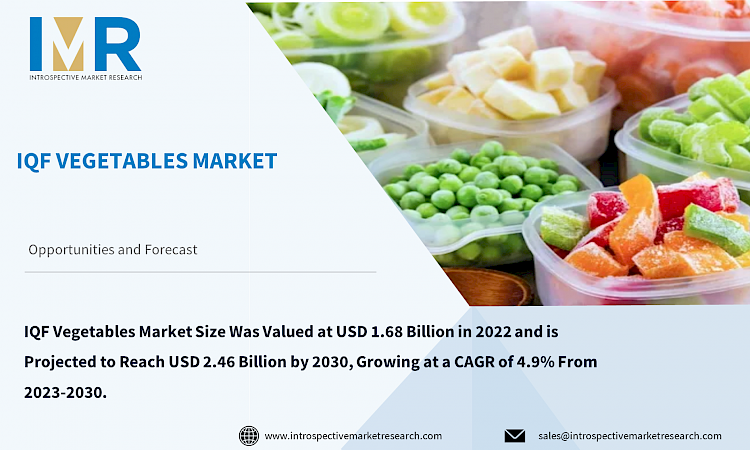
Market Overview:
Global IQF Vegetables Market size is projected to reach USD 2.246 billion by 2028 from an estimated USD 1.606 billion in 2021, growing at a CAGR of 4.9% globally.
Foods that are frozen are of good quality and have a high nutritional value. There is an increase in demand for some frozen vegetables, including corn, beans, and green peas, which may have better flavor than fresh produce. The Individual Quick-Frozen (IQF) method, a product of technological innovation and development, is largely responsible for the high quality of frozen food. Tiny crystals form as a result of the ultra-cold, ultra-fast freezing process, which freezes the product. Around -1 to -4 degrees Celsius, or 30 to 25 degrees Fahrenheit, water freezes into ice crystals, preserving the quality of the final product. Additionally, IQF technology is employed in the food processing industry for the preservation of vegetables and products made from them, as well as for food sustainability, transportation of vegetables, and other applications.
Top Key Players Covered In The IQF Vegetables Market:
- B&G Foods Holdings (U.S.)
- Capricorn Food Products (India)
- Dole Food (U.S.)
- Greenyard NV (Belgium)
- J.R. Simplot Co. (US)
- Kerry Group (Ireland)
- Pinnacle Foods (U.S.)
- SunOpta Inc. (Canada)
- Uren Food Group (U.S.)
- ConAgra Foods (U.S.)
- Alasko Food Inc. (Canada)
- Greenyard NV (Belgium) and Other Major Players
Market Dynamics and Factors:
Increasing demand for cuisines that necessitates the use of IQF vegetables is driving the market. Due to the population's shifting preferences towards frozen food, ready-to-eat food, longer-lasting products, and others, the demand for IQF technology for vegetables and vegetable-based products is rising. Furthermore, IQF vegetables and vegetable-based foods differ from frozen food and offer several advantages that help them stand out and draw in customers, including preservation, a high nutritional product, a low price, availability throughout the year, and better quality.
Advancements in the supply chains and distribution channels of fruits and vegetables are expected to increase the demand for the IQF vegetable market in the future. Better easiness and quality product, transparency in the distribution channel, and supply chain of vegetables which is expected to develop in upcoming years. The maximum amount of food losses is reduced in the fruits and vegetable supply chain due to the quality and match between supply and demand.
IQF Vegetables Market Report Highlight:
- By product type, the potatoes segment is anticipated to lead the growth of the IQF Vegetables market in the forecasted timeframe. Because there are more fast food restaurants and consumers seeking healthier options, therefore demand IQF potatoes is rising quickly.
- By equipment type, the load balancing segment is expected to have the highest share of the IQF Vegetables market over the projected period because it maintains the natural appearance, texture, and color of the vegetables during the freezing process is the biggest advantage of advanced tunnel freezers.
- By distribution channel, the online segment is set to develop at the highest CAGR during the forecasted timeframe. The rise of the frozen fruits and vegetables industry is anticipated to be fueled by the increasing use of smartphones and the internet,
- By application, the commercial segment is expected to have the highest share of the IQF Vegetables market over the projected period. The fact that IQF vegetables require less time for preparation and reduce customer waiting time, thus, fast food chains and quick-service restaurants have adopted them as substitutes for fresh vegetables. This fact drives the demand for the commercial segment
- The North American region is expected to have the highest share of the IQF Vegetables market over the projected period. Due to the population in the regions consuming more vegetables than any other region. Furthermore, there are significant key players present in these areas.
Key Industry Development:
- In November 2019, B&G started a new segment which is the giant-sized footprint for frozen food around 200000 sq ft Yuma, Ariz facility, which produces more than 30 SKUs of Green Giant brand frozen vegetables and vegetable-based products.
- In January 2020, ConAgra Foods Inc. declared that by 2025, it would make all of the plastic packaging it currently uses renewable, recyclable, and compostable.
North America
- The U.S.
- Canada
- Mexico
Eastern Europe
- Russia
- Bulgaria
- The Czech Republic
- Hungary
- Poland
- Romania
- Rest of Eastern Europe
Western Europe
- Germany
- UK
- France
- Netherlands
- Italy
- Spain
- Rest of Western Europe
Asia Pacific
- China
- India
- Japan
- Singapore
- Australia
- New-Zealand
- Rest of APAC
Middle East & Africa
- Turkey
- Saudi Arabia
- Qatar
- UAE
- Israel
- South Africa
South America
- Brazil
- Argentina
- Rest of SA




